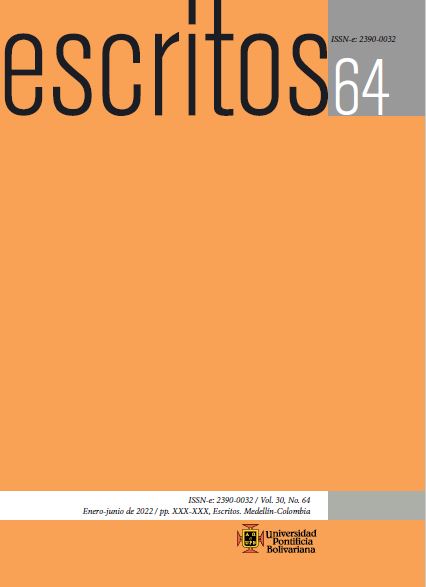La «Religiosidad A» como clave de lectura de la Primera Parte de La enfermedad mortal
Contenido principal del artículo
Resumen
La relación entre la Primera y la Segunda Parte de La enfermedad mortal es problemática. La lectura standard dice que la Primera Parte desarrolla una interpretación antropológica del yo y la Segunda Parte desarrolla una interpretación teológica del yo. Pero esta interpretación colisiona contra la definición inicial del yo como una relación derivada que se relaciona con el poder que la ha puesto. Este artículo se propone ofrecer una respuesta a esta cuestión. Nuestra tesis es que la solución a esta dificultad es la noción de «religiosidad A». Kierkegaard distingue dos tipos de religiosidad: una de ellas cae dentro de la esfera de la inmanencia (A), la otra dentro de la esfera de la trascendencia (B). En primer lugar, resumiremos los tres conceptos centrales de la «religiosidad A»: renuncia, sufrimiento y conciencia de culpa. En segundo lugar, intentaremos demostrar que el desarrollo de la conciencia desesperada de La enfermedad mortal (Primera Parte) se corresponde con el movimiento existencial de la «religiosidad A».
Referencias
Anderson, Thomas. “Is the Religion of the Eighteen Upbuilding Discourses Religiousness A?”. En International Kierkegaard Commentary Eighteen Upbuilding Discourses. Editado por Robert Perkins, 51-76. Macon: Mercer University Press, 2003.
Beabout, Gregory. Freedom and its Misuses: Kierkegaard on Anxiety and Despair. Milwaukee: Marquette University Press, 1996.
Come, Arnold. Kierkegaard as Humanist: Discovering my Self. Montreal: McGill-Queen’s University Press, 1995.
Dietz, Walter. Sören Kierkegaard: Existenz und Freiheit. Fráncfort del Meno: Hain, 1993.
Dip, Patricia. “El rol de Climacus en la estrategia comunicativa de Kierkegaard”. Horizontes Filosóficos, n.º 8 (2018): 23-36.
Elrod, John. Being and Existence in Kierkegaard’s Pseudonymous Works. Nueva Jersey: Princeton University Press, 1975.
Figal, Günter. “Die Freiheit der Verzweiflung und die Freiheit im Glauben: Zur Kierkegaard Konzeption des Selbstseins und Selbstwerdens in der ‘Krankheit zum Todes’”. Kierkegaardiana 13 (1984): 11-23.
Garrido Maturano, Ángel. “Del paganismo a la gracia: Una interpretación filosófica de la existencia religiosa en el pensamiento de S. Kierkegaard”. Cuadernos Salmantinos de Filosofía 48 (2021): 399-419. https://doi.org/10.36576/summa.144507
Grøn, Arne. “The Relation between Part One and Part Two of The Sickness unto Death”. En Kierkegaard Studies Yearbook 1997. Editado por Niels Cappelørn y Herman Deusser, 35-50. Nueva York: Walter de Gruyter, 1997. https://doi.org/10.1515/9783110243994.35
Hannay, Alastair. “Spirit and the Idea of the Self as a Reflexive Relation”. En International Kierkegaard Commentary: The Sickness unto Death. Editado por Robert Perkins, 23-38. Macon: Mercer University Press, 1987.
Hannay, Alastair. “Kierkegaardian Despair and the Irascible Soul”. En Kierkegaard Studies Yearbook 1997. Editado por Niels Cappelørn y Herman Deusser, 51-69. Nueva York: Walter de Gruyter, 1997. https://doi.org/10.1515/9783110243994.51
Hannay, Alastair. “Kierkegaard and the Variety of Despair”. En The Cambridge Companion to Kierkegaard. Editado por Alastair Hannay y Gordon Marino, 323-348. Cambridge: Cambridge Universtiy Press, 1998. https://doi.org/10.1017/CCOL0521471516.014
Heidegger, Martin. Ser y tiempo. Madrid: Trotta, 2003.
Kierkegaard, Søren. Søren Kierkegaard Papirer (Pap). Editado por P. H. Heiberg, V. Kuhr y E. Torsting. Copenhague: Gyldendal, 1909-1948.
Kierkegaard, Søren. Søren Kierkegaard Skrifter (SKS). Editado por Niel Cappelørn, Joakim Graff, Johnny Kondrup, Alastair McKinnon y Finn Mortensen. Copenhague: Søren Kierkegaard Forskningscenteret y Gads Forlag, 1997-2009.
Kierkegaard, Søren. Escritos de Søren Kierkegaard. Volumen 2: O lo uno o lo otro. Un fragmento de vida I [OO 1]. Madrid: Trotta, 2006.
Kierkegaard, Søren. La enfermedad mortal [EM]. Madrid: Trotta, 2008.
Kierkegaard, Søren. Post-scriptum no científico y definitivo a Migajas Filosóficas [PC]. México: Universidad Iberoamericana, 2009.
Kierkegaard, Søren. “El concepto de angustia”. En Escritos de S. Kierkegaard. Volumen 4/2, 125-278. Madrid: Trotta, 2016.
Klee, Louis. “The Politics of Selfhood with Constant Reference to Kierkegaard”. En Kierkegaard Studies Yearbook 2017. Editado por Heiko Schulz, Jon Stewart y Karl Verstrynge, 59-77, Nueva York: Walter de Gruyter, 2017. https://doi.org/10.1515/kierke-2017-0003
Kosch, Michelle. “Despair in Either/Or”. Journal of the History of Philosophy 44, n.º 1 (2006): 85-97. https://doi.org/10.1353/hph.2006.0013
Hong, Howard y Edna Hong. “Historical Introduction”. En The Sickness unto Death. Kierkegaard’s Writings. Vol. XIII, IX-XXIII. Nueva Jersey: Princeton University Press, 1980.
Malantschuk, Gregor. Kierkegaard’s Concept of Existence. Milwauke: Marquette University Press, 2003.
Malantschuk, Gregor. “Die Begriffe Immanenz und Transzendenz bei Sören Kierkegaard”. Neue Zeitschrift für Systematische Theologie und Religionsphilosophie 9, n.º 2 (1977): 225-246. https://doi.org/10.1515/nzst.1977.19.2.225
Marquard, Oddo. “Idealismo y teodicea”. En Las dificultades con la filosofía de la historia, 59-73. Madrid: Pre-Textos, 2007.
Nordentoft, Kresten. Kierkegaard’s Psychology. Oregon: Wipf & Stock, 2009.
Olesen, Michael. “The Climacean Alphabet: Reflections on Religiousness A and B from the Perspective of the Edifying”. En Kierkegaard Studies Yearbook 2005. Editado por Niels Cappelørn y Herman Deusser, 282-293. Nueva York: Walter de Gruyter, 2005. https://doi.org/10.1515/9783110185522.282
Olivares Bøgeskov, Benjamín. El concepto de felicidad en las obras de Søren Kierkegaard. México: Universidad Iberoamericana, 2015.
Parcero Oubiña, Oscar. “Verdad subjetiva, interioridad y pasión”. En Søren Kierkegaard: Una reflexión sobre la existencia humana. Editado por Luis Guerrero Martínez, 107-127. México: Universidad Iberoamericana, 2009.
Pattison, George. Kierkegaard’s Upbuilding Discourses: Philosophy, Literature and Theology. Nueva York: Routledge, 2002. https://doi.org/10.4324/9780203216576
Ringleben, Joachim. “Zur Aufbaulogik der Krankheit zum Tode”. En Kierkegaard Studies Yearbook 2005. Editado por Niels Cappelørn y Herman Deusser, 100-116. Nueva York: Walter de Gruyter, 1997. https://doi.org/10.1515/9783110243994.100
Roberts, Robert. “The Grammar of Sin and the Conceptual Unity of The Sickness unto Death”. En International Kierkegaard Commentary: The Sickness unto Death. Editado por Robert Perkins, 135-160. Macon: Mercer University Press, 1987.
Rocca, Ettore. Kierkegaard: Secreto y testimonio. Madrid: Universidad Pontificia Comillas, 2020.
Rodríguez, Pablo Uriel. “Lo edificante y lo cómico en Kierkegaard”. Teología y Cultura 17, n.º 22 (2020): 79-106.
Schulz, Heiko. “A Phenomenological Proof? The Challenge of Arguing for God in Kierkegaard’s Pseudonymous Authorship”. En Kierkegaard as Phenomenologist. Editado por Jeffrey Hanson, 101-127. Illinois: Northwestern University Press, 2010. https://doi.org/10.2307/j.ctv47w62p.10
Stokes, Patrick. Kierkegaard’s Mirrors: Interest, Self and Moral Vision. Londres: Pallgrave Macmillan, 2010.
Taylor, Mark. Kierkegaard’s Pseudonymous Authorship: A Study of Time and the Self. Nueva Jersey: Princeton University Press, 1975.
Theunissen, Michael. “Kierkegaard’s Negativistic Method”. En Psychiatri and the Humanities. Vol. 5: Kierkegaard’s Truth. The disclosure of the Self. Editado por Kerrigan y Smith, 381-423. New Haven: Yale University Press, 1981.






